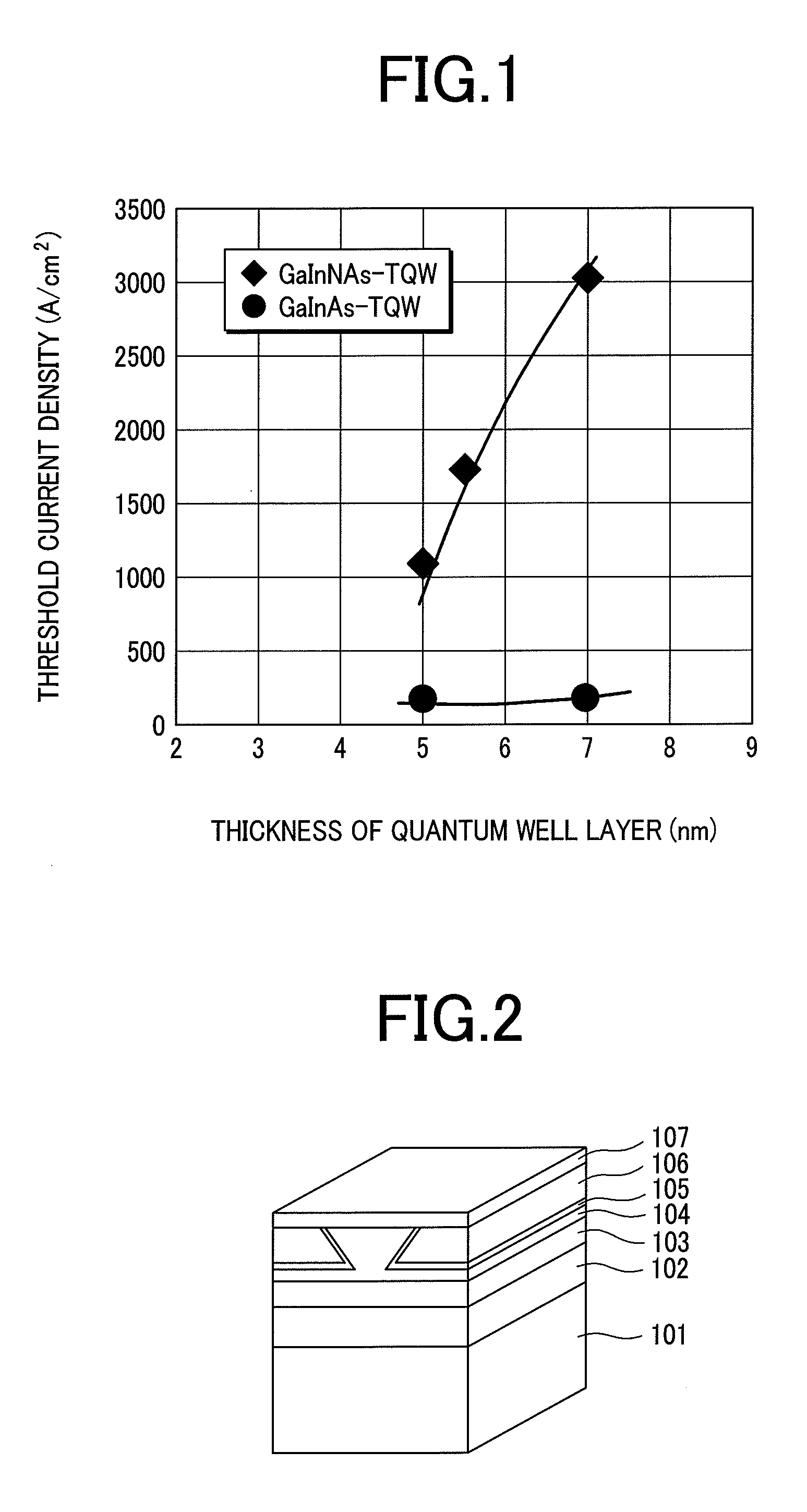Semiconductor Light Emitting Device
a technology of light-emitting devices and semiconductors, which is applied in the direction of semiconductor lasers, solid-state devices, lasers, etc., can solve the problem of thin critical thickness, and achieve the effect of ensuring the durability of critical thickness
- Summary
- Abstract
- Description
- Claims
- Application Information
AI Technical Summary
Benefits of technology
Problems solved by technology
Method used
Image
Examples
first embodiment
[0030] A first embodiment is an example of applying the invention to a narrow stripe type edge emitting laser. FIG. 2 shows a device structure of a narrow stripe edge emitting laser. In FIG. 2, reference numeral 101 denotes an n-GaAs substrate; 102, an n-GaInP cladding layer having a carrier concentration of 1×1018 cm−3; 103, an active layer; 104, a p-GaInP cladding layer having a carrier concentration of 1×1018 cm−3; 106, a polyimide insulation layer; 105, an SiO2 protective film; and 107, a p-electrode layer. A resonator length is 200 μm and coatings having reflectivity of 70% and 90% are applied to the front and back edges of a device, respectively. An epitaxial structure of the laser structure shown in FIG. 2 can be successively grown, for example, by a gas source molecular beam epitaxy using N radicals. Further, a similar structure can be obtained also by metal organic vapor phase epitaxy method. The first embodiment has a feature of having triple quantum well (TQW) structure i...
second embodiment
[0039] A second embodiment is an example of applying the invention to a narrow stripe edge emitting laser. FIG. 2 shows a device structure of a narrow stripe edge emitting laser. The second embodiment has a feature in that the active layer 103 shown in FIG. 2 has a triple quantum well structure formed by stacking the active layer shown in FIG. 6 by three layers.
[0040]FIG. 6 is a view showing an energy structure of the quantum well of the active layer 103 in FIG. 2. In FIG. 6, the quantum well of the invention comprises a quantum well layer 1 and GaAs barrier layers 2 and 6 stacked on both sides of the quantum well layer 1. The quantum well layer 1 is formed by successively stacking the GaInAs layer 4, the GaInNAs layer 3, and the GaInAs layer 5. It is assumed that the thickness of the GaInNAs layer 3 is L1, the thickness of the GaInAs layer 4 is L2, and the thickness of the GaInAs layer 5 is L3. Further, it is assumed that the thickness of the quantum well layer 1 is Lw and the sum...
third embodiment
[0042] A third embodiment is an example of applying the invention to a surface emitting laser. FIG. 8 is a structural view of a surface emitting laser. There are shown an n-GaAs substrate 201 having a thickness of 1.5 μm, an n-GaAs-AlGaAs DBR reflection mirror 202 having a thickness of 4 μm, an active layer 203, an AlAs oxide current blocking layer 204, a p-GaAs / AlGaAs DBR reflection mirror 205 having a thickness of 3.5 μm, and a p-electrode 206. The active layer 203 has triple quantum well structure formed by stacking the active layer shown in FIG. 3 or FIG. 6 by three layers. Also in the surface light emitting laser, since reduction in the critical thickness durability can be moderated by N addition in GaInNAs by applying the invention, the wavelength lengthening by about 30 m could be attained as shown in FIG. 4 compared with conventional techniques. Further, the threshold current is about 2 mA at a room temperature, about 2.5 mA at 85° C., and operation at 10 Gbit / s was attained...
PUM
 Login to View More
Login to View More Abstract
Description
Claims
Application Information
 Login to View More
Login to View More - R&D
- Intellectual Property
- Life Sciences
- Materials
- Tech Scout
- Unparalleled Data Quality
- Higher Quality Content
- 60% Fewer Hallucinations
Browse by: Latest US Patents, China's latest patents, Technical Efficacy Thesaurus, Application Domain, Technology Topic, Popular Technical Reports.
© 2025 PatSnap. All rights reserved.Legal|Privacy policy|Modern Slavery Act Transparency Statement|Sitemap|About US| Contact US: help@patsnap.com



